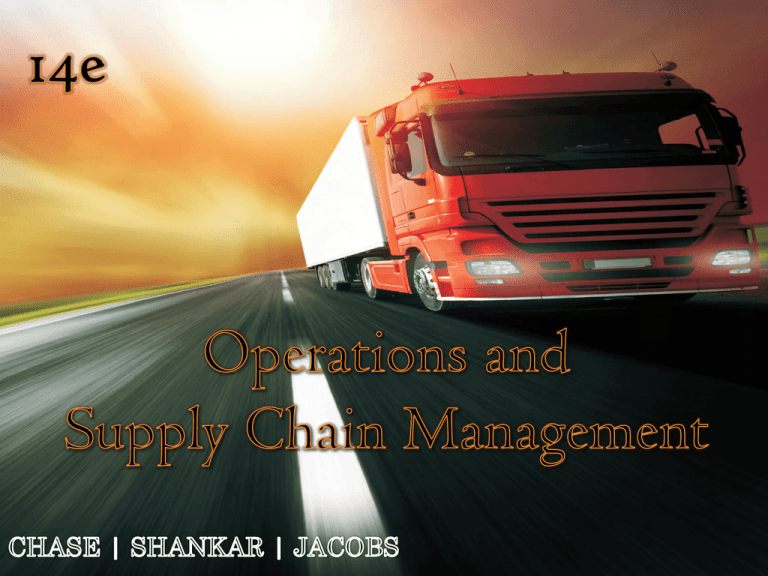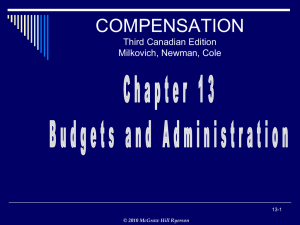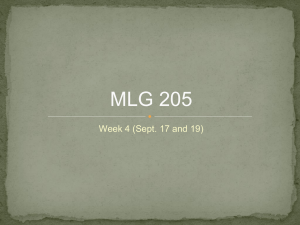
11–1
Chapter Eleven
McGraw-Hill/Irwin
Copyright © 2014 by The McGraw-Hill Companies, Inc. All rights reserved.
11–2
Copyright © 2014 by McGraw Hill Education (India) Private Limited. All rights reserved.
• LO11–1: Exemplify a typical business
process and how it can be analyzed.
• LO11–2: Compare different types of
processes.
• LO11–3: Explain how jobs are designed.
• LO11–4: Analyze manufacturing,
service, and logistics processes to ensure
the competitiveness of a firm.
11–3
• Cycle time: the average successive time between
completions of successive units
• Utilization: the ratio of the time that a resource
is actually activated relative to the time that it
is available for use
Copyright © 2014 by McGraw Hill Education (India) Private Limited. All rights reserved.
• Process: any part of an organization that takes
inputs and transforms them into outputs
11–4
• Analyzing the new electronic slot machine
• Comparison
Copyright © 2014 by McGraw Hill Education (India) Private Limited. All rights reserved.
• Analyzing the mechanical slot machine
• The slot machine is one of many casino
processes
11–5
• The basic elements can include tasks or
operations, flows of materials or customers,
decision points, and storage areas or queues
Copyright © 2014 by McGraw Hill Education (India) Private Limited. All rights reserved.
• Process flowcharting: the use of a diagram to
present the major elements of a process
• It is an ideal methodology by which to begin
analyzing a process
11–6
11–7
Copyright © 2014 by McGraw Hill Education (India) Private Limited. All rights reserved.
11–8
Copyright © 2014 by McGraw Hill Education (India) Private Limited. All rights reserved.
Stage 1
Multistage process
Stage 1
Stage 2
Copyright © 2014 by McGraw Hill Education (India) Private Limited. All rights reserved.
Single-stage process
Stage 3
11–9
Copyright © 2014 by McGraw Hill Education (India) Private Limited. All rights reserved.
• Buffer: a storage area between stages where
the output of a stage is placed prior to being
used in a downstream stage
• Blocking: occurs when the activities in a stage
must stop because there is no place to deposit
the item
• Starving: occurs when the activities in a stage
must stop because there is no work
• Bottleneck: stage that limits the capacity of
the process
11–10
11–11
Copyright © 2014 by McGraw Hill Education (India) Private Limited. All rights reserved.
• Parallel process: some of production has
alternative paths where two or more machines
are used to increase capacity
Copyright © 2014 by McGraw Hill Education (India) Private Limited. All rights reserved.
• Serial flow process: a single path for all stages
of production
• Logistics processes: the movement of things
such as materials, people, or finished goods
11–12
– Only activated in response to an actual order.
– Both work-in-process and finished goods inventory
kept to a minimum.
• Make-to-stock
– Process activated to meet expected or forecast
demand.
– Customer orders are served from target stocking
level.
Copyright © 2014 by McGraw Hill Education (India) Private Limited. All rights reserved.
• Make-to-order
• Hybrid
– Combines the features of both make-to-order and
make-to-stock.
11–13
11–14
Copyright © 2014 by McGraw Hill Education (India) Private Limited. All rights reserved.
– Sum of the value of raw materials, work-in-process, and
finished goods inventory
• Inventory turns
– Cost of goods sold divided by the average inventory
value
• Days-of-supply
– Inverse of inventory turns scaled to days
Copyright © 2014 by McGraw Hill Education (India) Private Limited. All rights reserved.
• Total average value of inventory
• Little’s law
– There is a long-term relationship among inventory,
throughput, and flow time
– Inventory = Throughput rate x Flow time
11–15
• 12 hours to make a car
• Assembles 200 cars per 8-hour shift
– Currently one shift
Copyright © 2014 by McGraw Hill Education (India) Private Limited. All rights reserved.
• Average cost $45
• Holds on average 8,000 batteries in raw
material inventory
11–16
• WIP = 25 batteries x 12 hours
• WIP = 300 batteries
Copyright © 2014 by McGraw Hill Education (India) Private Limited. All rights reserved.
• WIP = Throughput x Flow time
• Total = 8,000 + 300 = 8,300 batteries
11–17
• Flow time = Inventory/Throughput
Flow time = 8,000/200 = 40 days
Copyright © 2014 by McGraw Hill Education (India) Private Limited. All rights reserved.
• Value = 8,300 x $45 = $375,000
11–18
– Made high-speed, low-cost production possible
– Greatly enhanced standard of living
– Adverse effects on workers
• Job enrichment
– Making job more interesting to the worker
– Horizontal enrichment: worker performs a greater
number of variety of tasks
– Vertical enrichment: worker is involved in
planning, organizing, and inspecting work
Copyright © 2014 by McGraw Hill Education (India) Private Limited. All rights reserved.
• Specialization of labor
11–19
• Why use it?
– Schedule work and allocate capacity
– Motivate and measure work performance
– Evaluate performance
– Provide benchmarks
Copyright © 2014 by McGraw Hill Education (India) Private Limited. All rights reserved.
• Work measurement is a process of
analyzing jobs for the purpose of setting
time standards.
11–20
– Time study
– Work sampling
• Indirect methods
– Predetermined motion-time data system
– Elemental data
Copyright © 2014 by McGraw Hill Education (India) Private Limited. All rights reserved.
• Direct methods
11–21
Copyright © 2014 by McGraw Hill Education (India) Private Limited. All rights reserved.
Current Layout
11-22
11–22
• Capacity is 100 loaves per hour.
Copyright © 2014 by McGraw Hill Education (India) Private Limited. All rights reserved.
• Both bread making and packaging
operate the same amount of time.
• Packaging is idle for a quarter hour.
– Has 75 percent utilization.
11–23
11–24
Copyright © 2014 by McGraw Hill Education (India) Private Limited. All rights reserved.
– Produces 200 x 8 x 2 = 3,200
• Packaging runs three shifts.
– Produces 133.3 x 8 x 3 = 3,200
Copyright © 2014 by McGraw Hill Education (India) Private Limited. All rights reserved.
• Bread making runs two shifts.
• Capacities are roughly equal.
11–25
Copyright © 2014 by McGraw Hill Education (India) Private Limited. All rights reserved.
• Consider the restaurant in the casino.
Because it is important that customers be
served quickly, the managers have set up a
buffet arrangement where customers serve
themselves. The buffet is continually
replenished to keep items fresh. To further
speed service
• Fixed amount is charged for the meal.
11–26
Copyright © 2014 by McGraw Hill Education (India) Private Limited. All rights reserved.
• Customers take an average of 30 minutes to
get their food and eat.
• They typically eat in groups (or customer
parties) of two or three to a table.
• The restaurant has 40 tables. Each table can
accommodate four people.
• What is the maximum capacity of this
restaurant?
11–27
Copyright © 2014 by McGraw Hill Education (India) Private Limited. All rights reserved.
• Utilization: It is easy to see that the
restaurant can accommodate 160 people
seated at tables at a time. Actually, in this
situation, it might be more convenient to
measure the capacity in terms of customer
parties because this is how the capacity will be
used. If the average customer party is 2.5
individuals, then the average seat utilization
is 62.5 percent (2.5 seats/party 4; 4
seats/table) when the restaurant is operating
at capacity.
11–28
Copyright © 2014 by McGraw Hill Education (India) Private Limited. All rights reserved.
• Cycle time: When operating at capacity,
is 0.75 minute (30 minutes/table: 40
tables). So, on average, a table would
become available every 0.75 minute or
45 seconds.
• Capacity: The restaurant could handle
80 customer parties per hour (60
minutes/0.75 minute/party).
11–29
Copyright © 2014 by McGraw Hill Education (India) Private Limited. All rights reserved.
• The problem with this restaurant is that
everyone wants to eat at the same time.
Management has collected data and
expects the following profile for customer
parties arriving during lunch, which
runs from 11:30 a.m. until 1:30 p.m.
Customers are seated only until 1:00
p.m.
11–30
11–31
Copyright © 2014 by McGraw Hill Education (India) Private Limited. All rights reserved.
Copyright © 2014 by McGraw Hill Education (India) Private Limited. All rights reserved.
• Restaurant operates for two hours for lunch and the
capacity is 80 customer parties per hour.
• A simple way to analyze the situation is to calculate
how we expect the system to look in terms of number
of customers being served and number waiting in line
at the end of each 15-minute interval (a snapshot
every 15 minutes).
• The key to understanding the analysis is to look at the
cumulative numbers. The difference between
cumulative arrivals and cumulative departures gives
the number of customer parties in the restaurant
(those seated at tables and those waiting).
11–32
• Cycle time for the entire restaurant is 45 seconds per
customer party at this time (this means that on
average, a table empties every 45 seconds or 20 tables
empty during each 15-minute interval). The last party
will need to wait for all of the earlier parties to get a
table, so the expected waiting time is the number of
parties in line multiplied by the cycle time.
Copyright © 2014 by McGraw Hill Education (India) Private Limited. All rights reserved.
• Since there are only 40 tables, when the cumulative
difference through a time interval is greater than 40,
a waiting line forms.
11–33
Copyright © 2014 by McGraw Hill Education (India) Private Limited. All rights reserved.
• In the following table, when the cumulative number
of parties is 50, there are 10 parties waiting to be
seated (since there are only 40 tables).
• The average time they wait is 10 x 45 secs = 7.5
minutes.
• During 12:00 to 12:15, parties that arrived during
11:30 to 11:45 would have left, which makes the
cumulative number of parties at the end of 12:15 =
50 (number at the end of 12:00) + 30 (arrivals
during 12:00 to 12:15) – 15 (departures during 12:00
to 12:15) = 65.
11–34
11–35
Copyright © 2014 by McGraw Hill Education (India) Private Limited. All rights reserved.
11–36
Copyright © 2014 by McGraw Hill Education (India) Private Limited. All rights reserved.
• Route has 60 stops
• Each bus has seating capacity of 50
Copyright © 2014 by McGraw Hill Education (India) Private Limited. All rights reserved.
• Two hours for the route during peak
traffic
– Another 30 passengers can stand
• Busy much of the day
11–37
– In general, average wait is ½ cycle time.
• If two buses used…
– Cycle time is one hour
– Average wait is 30 minutes.
Copyright © 2014 by McGraw Hill Education (India) Private Limited. All rights reserved.
• With one bus, maximum wait is two hours.
• If bus is halfway through cycle, wait is one hour.
• Average wait is one hour.
• For a two-minute wait…
– Need four-minute cycle time.
– Need 30 buses (120 minutes/4 minute cycle time).
11–38
– 50 seated
– 30 standing
• 30 buses can accommodate…
Copyright © 2014 by McGraw Hill Education (India) Private Limited. All rights reserved.
• Each bus has total capacity of 80
passengers.
– 1,500 seated
– 2,400 total
11–39
11–40
Copyright © 2014 by McGraw Hill Education (India) Private Limited. All rights reserved.
– Need at least 40 buses during rush hours.
• With 40 buses all the time…
– 24,000 seat-hours available.
40 buses x 12 hours x 50 seats per bus
Copyright © 2014 by McGraw Hill Education (India) Private Limited. All rights reserved.
• With 30 buses, many will stand.
• During morning and afternoon rush, not all
customers can be accommodated.
• 25,875 seat-hours needed.
– 107.8 percent utilization
– 7.8 percent of customers must stand
11–41
• Change the sequence of activities.
• Reduce interruptions.
Copyright © 2014 by McGraw Hill Education (India) Private Limited. All rights reserved.
• Perform activities in parallel.
11–42










